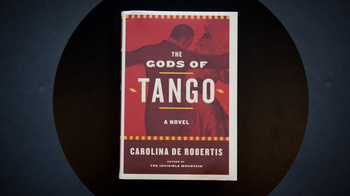During the last 25 years, Argentine tango has gone through a worldwide renaissance of interest. You can now dance tango in almost every major city on all continents. When you dance, the accompanying music comes from a very long tradition of respect for the past that is nonetheless enriched by constant innovation. A few tango musicians -- Carlos Gardel and Astor Piazzolla, most notably -- have passed into the pantheon of world renown, as have a few of the dancers, like Juan Carlos Copes, María Nieves and Carlos Gavito.
Carolina De Robertis is a novelist living in the United States and writing primarily in English. She is of Uruguayan roots, however, and has written provocatively and deeply about characters whose entire consciousness derives from the land, the traditions and the politics of Uruguay and Argentina. Her novel Perla is for me one of the most perceptive -- and startling -- accounts of the results of the terrible military governments that destroyed so many lives in Argentina during the 1970s and 80s.
De Robertis's new novel is The Gods of Tango, published by Knopf. In 1913, 17-year-old Leda arrives by ship in Buenos Aires, from Italy, ostensibly to be greeted by her new husband Dante. Once on shore, she learns that Dante has recently been killed in a street battle between syndicalists and the police. With only the clothes on her back and a single trunk containing her things, a little money, and the violin that her cherished father gave her after having been given it by his father, Leda moves into a conventillo, named La Rete, in the poor wharf-side neighborhood of La Boca. Conventillos basically were tenements, some set up by the Argentine government, others privately run, to house the many thousands of immigrants pouring into Buenos Aires during the first years of the twentieth century. The conditions were uniformly terrible, with many people crowded into warrens of single rooms. The conventillo would often have a central patio with a source of water for cooking and washing, which would be the gathering place for the tenants. These sprawling edifices housed people from all over the world, and must have been a polyglot confusion of languages, cultures, manners of dress and, most principally for Leda's purposes, music.
She hears her first tango in La Rete, and is immediately smitten by it. She has never even imagined such rhythmic intensity before, or such soulful intent and passion, in any of the music she has ever heard. She can play her father's violin (although at first her efforts are insubstantial), and she determines to master the tango.
There is, however, a problem.
Tango in 1913 Buenos Aires was the domain of men, and men alone. The only women involved were those who worked in the many boliche cafes and bordellos of Buenos Aires, and the duties of those women had little to do with music. The very idea of a woman playing tango was ridiculous to the men. Women were incapable of doing so, it was thought. There was no place for them on the street corner or in the café. The first requirement for any tango musician was that he be a man.
Leda comes to understand this quickly. Despite her very conservative Catholic upbringing in Italy, her complete isolation in Buenos Aires, her worries about what her family would say and the considerable physical danger that could lay waiting for her, she decides upon a change. Wrapping her breasts to diminish their presence, getting her hair cut in the style of a man, and dressing in her deceased husband's clothes, Leda leaves the conventillo and takes to the Buenos Aires streets, now calling herself Dante, after her deceased husband. She does so with violin in hand.
Leda remains so disguised for the rest of the novel, and she becomes remarkably well known as a musician. Working at first in the poorest of little boliches, she hones her talent until she becomes one of the best tango violinists on the Buenos Aires scene. But she does so as a man, and the disguise -- and what it teaches her about the privileges that men enjoy that are forbidden to women -- becomes the very vehicle for her rise to tango eminence.
Women are fascinated by this strange fellow Dante, and during her first years as a man, Dante becomes involved with a few of them. Suddenly, a new kind of heart is opened in her, and she finds avenues to affection with those women that surely, she thinks, must be sinful. But she cannot draw away from such affection because it also leads Dante to deep, compelling love. The way De Robertis presents the confusions that arise, for Dante and for her lovers, is one of the great innovations of this novel. De Robertis writes with considerable passion and beauty about the kinds of love that Dante finds and, of course, the kinds of sex that she finds. This novel contains some of the loveliest and most riveting writing about sensuality that I've ever encountered.
Dante's efforts to keep her secret are threatened numerous times through the book, and her close calls with possible discovery are all memorable.
For anyone who cares about tango, this novel is a fine addition to the history of that soulful music in its Rio de La Plata birthplace. It is also a sensuous, thoughtful and beautifully rendered look at the complications that can arise -- and the solutions that can be found -- when a woman is told that she cannot do something upon which her heart insists.


